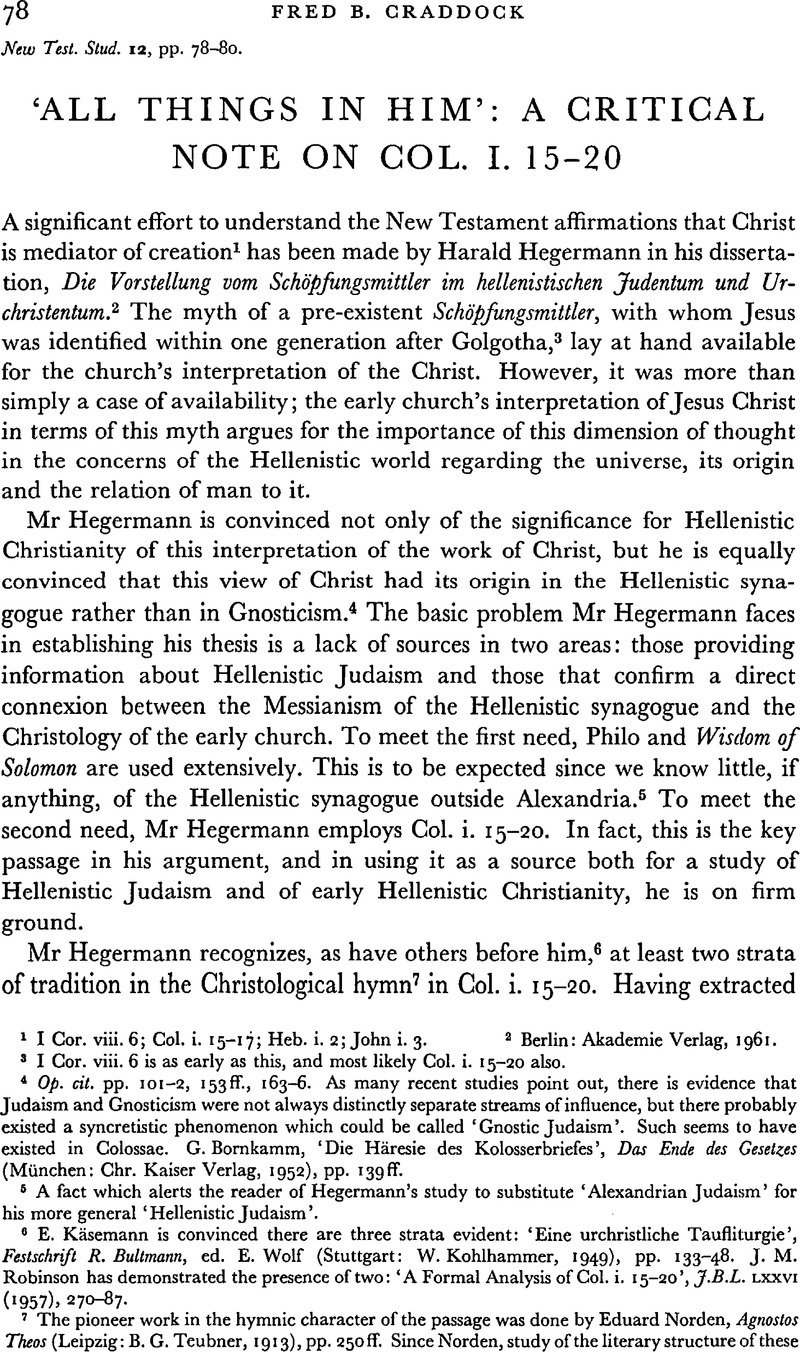No CrossRef data available.
Article contents
‘All Things in Him’: A Critical note on Col. i. 15–20
Published online by Cambridge University Press: 05 February 2009
Abstract

Information
- Type
- Short Studies
- Information
- Copyright
- Copyright © Cambridge University Press 1965
References
page 78 note 1 I Cor. viii. 6; Col. i. 15–17; Heb, . i. 2Google Scholar; John, i. 3.Google Scholar
page 78 note 2 Berlin: Akademie Verlag, 1961.Google Scholar
page 78 note 3 I Cor. viii. 6 is as early as this, and most likely Col. i. 15–20 also.
page 78 note 4 Op. cit. pp. 101–2, 153ff., 163–6.Google Scholar As many recent studies point out, there is evidence that Judaism and Gnosticism were not always distinctly separate streams of influence, but there probably existed a syncretistic phenomenon which could be called ‘Gnostic Judaism’. Such seems to have existed in Colossae. Bornkamm, G., ‘Die Haresie des Kolosserbriefes’, Das Endo des Gesetzes (Munchen: Chr. Kaiser Verlag, 1952), pp. 139 ff.Google Scholar
page 78 note 5 A fact which alerts the reader of Hegermann’s study to substitute ‘Alexandrian Judaism’ for his more general ‘Hellenistic Judaism’.
page 78 note 6 Käsemann, E. is convinced there are three strata evident: ‘Eine urchristliche Taufliturgie’, Festschrift R. Bultmann, ed. Wolf, E. (Stuttgart: W. Kohlhammer, 1949), pp. 133–48.Google ScholarRobinson, J. M. has demonstrated the presence of two: ‘A Formal Analysis of Col. i. 15–20’, J.B.L. LXXVi (1957), 270–87.Google Scholar
page 78 note 7 The pioneer work in the hymnic character of the passage was done by Eduard Norden, Agnostos Theos (Leipzig: B. G. Teubner, 1913), pp. 250 ff.Google Scholar Since Norden, study of the literary structure of these lines has been done by many, including (in addition to Käsemann and Robinson): Dibelius, M., An die Kolosser, Epheser, An Philemon (Handbuch zum N.T.) (Tübingen: J. C. B. Mohr, 1927), pp. 6ff.Google Scholar; Masson, C., L’Epitre de saint Paul aux Colossiens (Commentaire du N.Y.) (Neuchâtel: Delacheux et Niestlé, 1950), pp. 106 ff.Google Scholar; Lohmeyer, E., Die Briefe an die Kol. and an Philemon, 11th ed. (Göttingen: Vandenhoeck and Ruprecht, 1956), pp. 15 ff.Google Scholar; Benoit, P., Les Epitres de Saint Paul aux Phil., à Philém., aux Col., aux Eph. (La Sainte Bible), 3rd ed. (Paris: Les Edit. du Cerf, 1959), pp. 57ff.Google Scholar; Maurer, C., ‘Die Begrundung der Herrschaft Christi über die Mächte nach Kol. i. 15–20’,Google ScholarWort und Dienst, Jahrbuch der theologischen Schule Bethel, 1v (1955), 79 ff.Google Scholar; Bammel, E., ‘Versuch Col. i. 15–20’, Z.N.W. LII (1961), 88ff.Google Scholar
page 79 note 1 Op. cit. pp. 91 ff.Google Scholar It is not my present purpose to debate the merits of Hegermann’s analysis which, by extracting lines 116b c, 17a, a portion of 18a, and 20 c, leaves an original hymn of two strophes of five lines each. The effort after symmetry is at points strained and artificial.
page 79 note 2 Ibid. p. 110.
page 79 note 3 These are briefly but persuasively given by Robinson, op. cit. pp. 277–80Google Scholar and need not be repeated here.
page 79 note 4 Norden, , op. cit. pp. 240–1.Google Scholar
page 79 note 5 Op. Cit. pp. 100, 107–8, 165–6.Google Scholar
page 79 note 6 Admittedly this compound of Greek and Latin is a hybrid formation but may be justified functionally in contrast to pre-existent.
page 80 note 1 This may explain why the rabbis with their positive view of existence grounded in the doctrine of creation made little use of the category of pre-existence and even then only to affirm all things existed from eternity in the will of God.
page 80 note 2 ii. 16–23. â έόρακεν έμβατεύων in ii. 18 is baffling.
page 80 note 3 ii. 18.
page 80 note 4 δίά τ ⋯υ αίματος τ ⋯υ σταυρ ⋯υ αὐτου in i. 20 iS a phrase added by the writer of the epistle and does not belong to the original hymn.
page 80 note 5 Philo himself includes such mythology in his discussions of Logos. For him Logos is the man of God ( De Conl 11, 41Google Scholar), the image of God ( De Conf. 28, 147Google Scholar), the first begotten son ( De Agric. 12, 51Google Scholar; De Mutat. 114–16Google Scholar). But it is Philo’s World-Soul, the universe-pervading Logos that Hegermann selects to enlighten Col. i rather than the pre-existent Heavenly Man imagery. The fact is, Philo mixes mythological and philosophical terms and ideas in such a way as to make it possible to cite Philo as background for many viewpoints. Mr Hegermann has simply selected the ‘wrong’ Philo at this point.

